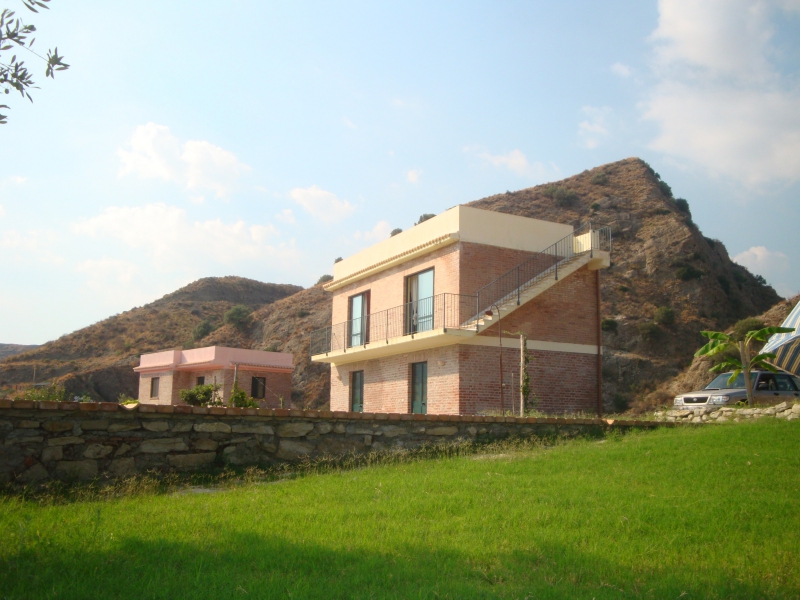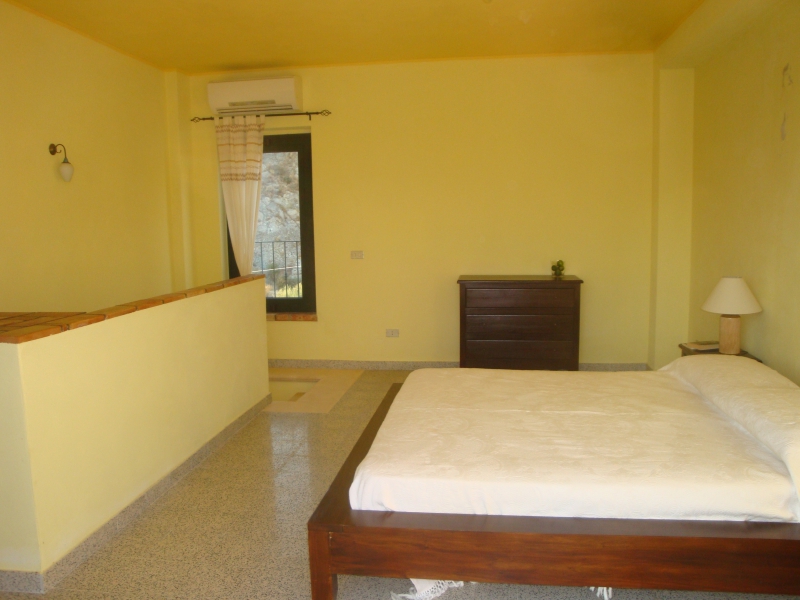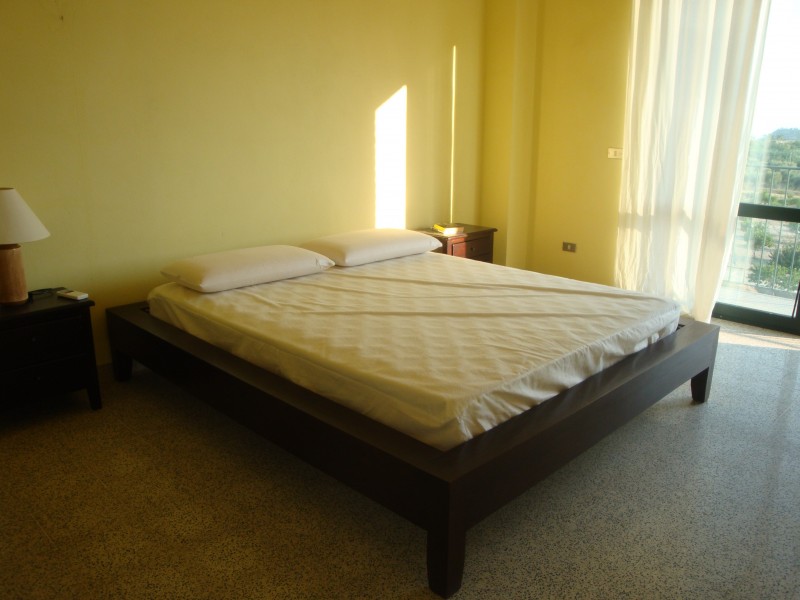Rio Rosa B&B
Disponibilita Camere
Camere
-
 Max:
Max:



Servizi Camera: Conditioned Air, Park and Garden, Swimming Poll
La casa Villa Peperoncino si trova da sola su un piccolo promontorio un po distaccato dalle altre case.
La casa in affitto è circondata da un grande giardino a disposizione degli ospiti, e con un magnifico panorama a 360°.
All’interno ha una grande camera con letto matrimoniale e bagno in camera, la cucina-soggiorno con un comodo divano letto doppio.
La cucina e completamente attrezzata, per 4 persone.
La casa è fornita di aria condizionata.






Letti: Letto Matrimoniale e divano letto doppio
-
 Max:
Max:



Servizi Camera: Conditioned Air
Bergamotto 1 è tinteggiato in giallo con la cucina in un caldo arancione.
L’ appartamento in affitto si sviluppa su due piani:
- il piano terra con l’ingresso , cucina e bagno.
- Il piano superiore ha il letto matrimoniale, un letto aggiuntivo e la grande finestra panoramica con il terrazzo per godere della vista sulla valle con il bergamotteto.
A piano terra con la cucina si trova un divano letto doppio.
Davanti all’ingresso c’è un piccolo giardino, dove godersi le serate in completo relax.
La cucina è dotata di tutte le attrezzature necessarie, e l’appartamento dispone di aria condizionata.






Letti: Letto Matrimoniale, Letto e Divano Letto Due Posti
-
 Max:
Max:



Servizi Camera: Conditioned Air, Park and Garden
Bergamotto 2 è colorato di rosa tenue, come spesso si usava nelle case di campagna una volta.
L’appartamento e simile e speculare al Bergamotto 1, si sviluppa su due piani con al piano terra ingresso, cucina e bagno, il piano superiore con letto matrimoniale,letto aggiuntivo e grande finestra panoramica. Davanti alla camera c’è il terrazzo con vista fino al mare.
Anche qui il soggiorno cucina dispone di un comodo divano letto per due persone.
La cucina è tutta attrezzata con tutto il necessario,e l’appartamento è dotato di aria condizionata.
Un piccolo giardinetto completa sul davanti la casa.






Letti: Letto Matrimoniale, letto aggiuntivo e divano letto due posti
General Info
Rio Rosa is the brainchild of a well-known Milanese lawyer who, tired of the metropolis, returned to his native land and created a small oasis in an area full of history and natural resources but which has always been underestimated. The Rio Rosa B & B is located in the heart of Calabria’s Bovesia, [Bova district] a Mediterranean crossroads of languages and culture. Here you will discover the hospitality, customs and wealth of an exceptional area.
Five thousand years of tradition , past and present.
Rio Rosa offers you highly enjoyable excursions to places between the sea and mountains, surrounded by the fragrances of Mediterranean cuisine and the fruit and vegetables we produce and make available to our guests. Then there is the aroma of the Ionic Bergamot.
Prices
The Rio Rosa B&B charges a weekly rate per apartment for 4 as follows:
High season: July-August €500.00
In-between season: June and September €450.00
Low season: the rest of the year €350.00
Compulsory final cleaning service: €30.00
Check-in
Flexible
Check-out
Flexible
Check-in
Check-out
Servizi
 Conditioned Air
Conditioned Air Park and Garden
Park and Garden Parking
Parking Swimming Poll
Swimming Poll
Bova Marina

Situated between Capo Crisafi, Capo San Giovanni d’Avalos and the Amendolea River, Bova Marina was founded in relatively recent times as a satellite of inland Bova.
The ancient port of Bova, in Greek Yalo tu Vùa, Bova Marina, became an urban settlement in its own right during the late nineteenth century, on the bay at the San Giovanni D’Avalos Cape, the Ionian Sea’s most elegant headland.
The hamlet of Bova Marina was built, in fact, in the nineteenth century at the behest of the then bishop of Bova, Mons. Dalmazio D’Andrea, who purchased considerable amounts of land on the banks of the Sideroni River to give to the poor. This event is recalled in a plaque on the façade of Bova Marina’s Church of the Immacolata, founded by the same bishop. Bova Marina grew during the period of urbanisation of the Ionian coast caused by a series of favourable circumstances. The construction of the railway line and of the SS 106 highway. Also, increases in revenue due to the cultivation of the gradually-reclaimed alluvial plains, no longer the target of the Turkish invasions that had threatened these shores at the beginning of the nineteenth century. In the seventeenth century, the present plain where the seaside town grew up was called simply the “small plain”, to distinguish it from that of San Pasquale which was called the “great plain”. In 1910, this small fishing village became a municipality in its own right, as little by little, citizens from inland Bova, who found it increasingly advantageous to earn their living by cultivating bergamot, later jasmine as well, moved to the coast.
TOWNLANDS AND LOCALITIES
Amygdalià, Apàmbelo, Borgo, Centro, Costa dei Saraceni, Fondo Vena, Mesofugna, San Pasquale.
HISTORY
Jalò tu Vùa is a particularly rich historical area and one of the Bovesìa’s most prominent archaeological locations. Its prestige is extraordinary thanks, in particular, to the archaeological finds bought to light in the Deri district of the San Pasquale valley during surveys carried out by Liliana Costamagna between 1983 and 1987. The site, in addition to revealing traces of a tenth-century BC proto-historic settlement, contains the ruins of a Roman villa, an aqueduct and a number of tombs, as well as the foundations of a building from the fourth century A.D., identified as a synagogue, as testified by its mosaic floor bearing symbols of the Jewish iconographic tradition: a menorah, a shofar and cedar and palm leaves. It seems to be the oldest of its kind in the West after that of Ostia Antica.
The synagogue stood in a location containing other buildings, and, therefore, seems to indicate the existence of a small village near the sea, once linking Reggio with the other towns on the Ionian coast.
This locality appears to be the ancient Scyle, which features in different ways in ancient Itineraria. This fact is confirmed, it would seem, by the presence of Scillàca as a place name in the Deri district.
Many prehistoric settlements [70] have come to light again around the Bova Marina area, especially some belonging to the Neolithic, Copper and Bronze Ages. The oldest in the Umbro vicinity, 200 metres above sea level and close to the new road linking Bova Marina and Bova, was originally inhabited from about the first half of the sixth millennium BC to 4000 BC as well as during the during later Copper Age. Among the most distinctive findings brought to light is a ritual deposit of ceramic containers, associated, most likely, with the abandonment of the site, and buildings dating back to the sixth millennium BC that seem to have been dwelling places. The excavations have also uncovered some typical samples of Neolithic material: ceramics bearing engraved decorations, utensils in chipped stone, stone axes, tools made from flint and obsidian, plain and decorated vases.
EXPLORING THE TOWN
Bova Marina provides those interested in learning about the oldest cultural aspects of the area with the opportunity of following the grand Parco archeologico Archeoderi [Archeoderi Archaeological Park] route through the San Pasquale neighbourhood. Here it is possible to visit the locality surrounding the synagogue, and view, inside the Antiquarium, several finds dating from the Neolithic, Bronze, and Magna-Grecian-Byzantine ages, besides the above mentioned, precious Jewish mosaic.
Continuing along the valley, it is also possible to visit the ruins of the small Byzantine church of the Panagia – one of the many places of worship found along the Byzantine-age route of the Italo-Greek saints – whose circular structure recalls the baptistery of Santa Severina and the Cattolica di Stilo.
By way of further testimony to the area’s Byzantine rite, on top of a small hill and nestling amid olive trees and broom, stand the ruins of another Byzantine gem, the tiny tenth-century church of San Niceto in the Apambelo locality.
In Bova Marina we find the headquarters of the I.R.S.S.E.C. [Istituto Regionale Superiore Studi Elleno Calabri- The Higher Regional Institute for Greek-Calabrian Studies] where, one can follow a recently-inaugurated presentation of the course of traditional local crafts at the Museo della Civiltà Contadina [The Museum of Peasant Civilization], which greatly enhances the town’s cultural services.
Furthermore, to safeguard the language and culture of the Greeks of Calabria, two territorial organisations, Odisseas and Jalò tu Vùa, are particularly active.
The San Giovanni d’Avalos headland or “Ten arcan tou Boòs” [Bova Point], as it is called in an eleventh-century Byzantine document, is particularly fascinating. On the crest of the lovely promontory, which the Greeks dedicated to Hercules, stand a number of monuments. Symbolically recollective of the history of the Graecanic coastal area, they include, a sixteenth-century chivalric tower, a small eighteenth-century church, sponsored by a family of aristocratic patrons, the Marzano, and a huge bronze statue of the Madonna del Mare [Our Lady of the Sea], brought here by helicopter in 1962. Devotion to the Virgin, celebrated here during the first week in August, with a suggestive procession to the sea, is associated with the presence, once, of a church dedicated to Our Lady of Porto Salvo, which stood at the foot of the promontory until, at the end of the seventeenth century, a violent tidal wave wiped it out completely. The feast of Our Lady of Porto Salvo is related to its role as a leeward haven that Capo San Giovanni d’Avalos played through the ages. The Skile statio found in the vicinity of San Pasquale, as well as the archaeological remains discovered at Tripepi, on the eastern outskirts of Bova Marina, were connected with the presence of a nearby commercial maritime port, as well as the Sideroni and San Pasquale rivers.
Continua a leggere














